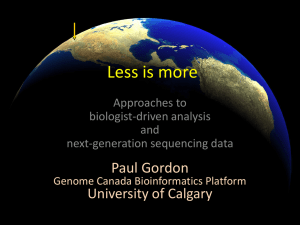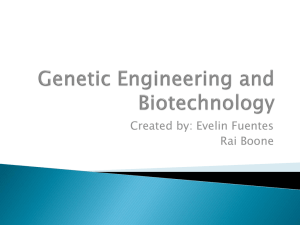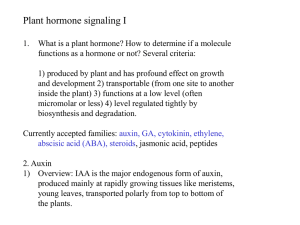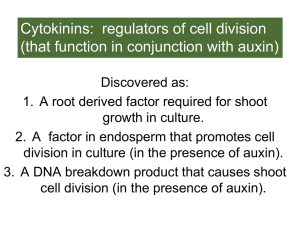Lec # 8 Fermentation biotechnology
advertisement
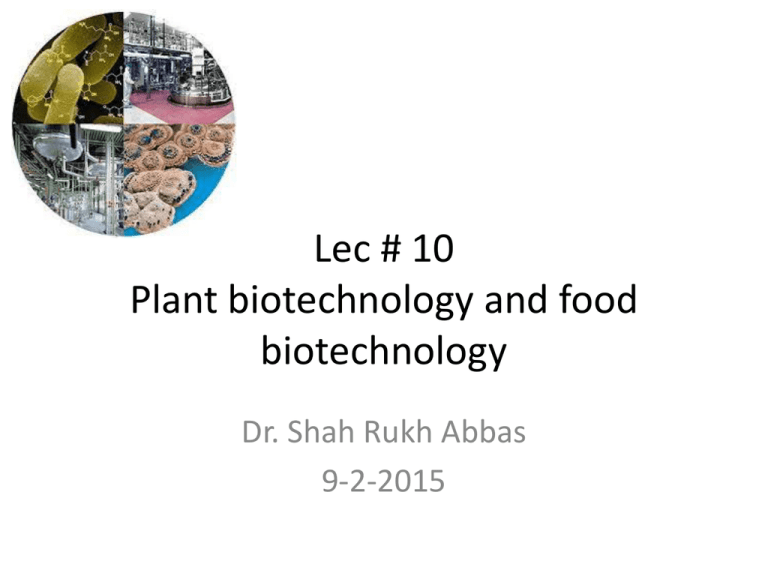
Lec # 10 Plant biotechnology and food biotechnology Dr. Shah Rukh Abbas 9-2-2015 The world population grows and grows ... A major objective of plant science is to increase food production; current estimates indicate that we need to increase production by 70% in the next 40 years. Malnutrition and hunger disproportionately kill children In 2004, 60 million people worldwide died. (Source: World Health Organization, 2008) Malnutrition and hunger disproportionately kill children 10 million of them were children under 5 years of age, of which 99% lived in low- or middle-income countries (Source: The State of the World's Children, UNICEF, 2007) Malnutrition and hunger disproportionately kill children 5 million children under the age of 5 die each year due to undernutrition and related causes. That’s one preschool-aged child dying a preventable death every six seconds. Malnutrition and hunger disproportionately kill children A lack of adequate vitamin A kills one million children a year. (Source: Vitamin and Mineral Deficiency, A Global Progress Report, UNICEF) Drought stress is compounded by increasing global temperatures In warm regions, crop yields can drop ~3 – 5% with every 1°C increase in temperature. One model of mean temperature increases in agricultural lands by 2050. Gornall, J., Betts, R., Burke, E., Clark, R., Camp, J., Willett, K., and Wiltshire, A. Implications of climate change for agricultural productivity in the early twenty-first century. Phil. Trans. Royal Soc. B: 365: 2973-2989.m Plant growth is often limited by drought stress Image source: IWMI WHAT CAN SCIENTISTS DO ABOUT THIS? Plant scientists can contribute to the alleviation of hunger By developing plants that are drought or stress tolerant require less fertilizer or water are resistant to pathogens are more nutritious • Plant biotechnology is a process to produce a genetically modified plant by removing genetic information from an organism, manipulating it in the laboratory and then transferring it into a plant to change certain of its characteristics . • It chiefly involves the introduction of foreign genes into economically important plant species, resulting in crop improvement and the production of novel products in plants. • The goal of plant breeding is to combine desirable traits from different varieties of plants to produce plants of superior quality. • A transgenic crop plant contains a gene or genes which have been artificially inserted instead of the plant acquiring them through pollination. • The inserted gene sequence (known as the transgene) may come from another unrelated plant, or from a completely different species. • Example transgenic Bt corn, for example, which produces its own insecticide, contains a gene from a bacterium. • Corn and soybean to resist pest in US are in the forefront of Biotechnological revolution. Plant biotechnology techniques A. Selective breeding : by crossing two members of the same species which has dominant alleles for particular genes such as long life and quick metabolism in one organism crossed with another organism possessing genes for fast growth and high yield. when they are crossed they will produce at least some offspring, called hybrid, that will show ALL of these desirable characteristics. B. Gene cloning provides a new dimension to crop breeding by enabling directed changes to be made to the genotype of a plant, circumventing the random processes inherent in conventional breeding. Two general strategies have been used: 1. Gene addition, in which cloning is used to alter the characteristics of a plant by providing it with one or more new genes; e.g. Plants that make their own insecticides, or herbicide resistant crops. (BT crops). 2. Gene subtraction, in which genetic engineering techniques are used to inactivate one or more of the plant’s existing genes; e.g. silencing the gene for fruit ripening in tomato to increase shelf life Methods to transfer gene (Plant transformation) 1. Biolistic approach In the "biolistic" (a cross between biology and ballistics )or "gene gun" method, microscopic gold beads are coated with the gene of interest and shot into the plant cell with a pulse of helium. • Once inside the cell, the gene comes off the bead and integrates into the cell's genome. Its also called cellular target approach. Biorad's Helios gene gun 2. Electroporation of protoplasts (cells grown without a cell wall): Plant cells could be "electroporated" or mixed with a gene and "shocked" with a pulse of electricity, causing holes to form in the cell through which the DNA could flow. The cell is subsequently able to repair the holes and the gene becomes a part of the plant genome. 3. Agrobacterium-mediated gene transfer Agrobacterium tumefaciens is a • Common soil bacterium acts as a natural plant parasite • Multiply rapidly after inducing an infection • Result in tumor formation; The “Crown galls” And so their natural ability of gene transfer is manipulated for genetic engineering of plants • Agrobacterium tumefaciens is a common soil bacterium that causes crown gall disease by transferring some of its DNA to the plant host. • The transferred DNA (T-DNA) which is part of its Tumour inducing plasmid (Ti-plasmid )is stably integrated into the plant genome, where its expression leads to the synthesis of plant hormones and thus to the tumorous growth of the cells. • After discovering this process, scientists were able to "disarm" the bacterium, put new genes into it, and use the bacterium to harmlessly insert the desired genes into the plant genome How does it transfer? Ti-plasmid T-DNA for gene transfer Flavr SavrTM tomato-First GM plant • Introduced in 1994 by Calgene Inc. We need plants that grow well even under stressful conditions Heat and drought reduce plant yields We need plants that grow well even under stressful conditions Heat and drought reduce plant yields More land must be cleared to grow more crops We need plants that grow well even under stressful conditions Heat and drought reduce plant yields Removing trees to make way for crops puts more CO2 into the atmosphere More land must be cleared to grow more crops Altering a single gene can increase plants’ drought tolerance Drought-resistant Wild-type Well-watered 10 days drought 20 days drought After re-watering Yu, H., Chen, X., Hong, Y.-Y., Wang, Y., Xu, P., Ke, S.-D., Liu, H.-Y., Zhu, J.-K., Oliver, D.J., Xiang, C.-B. (2008) Activated expression of an Arabidopsis HD-START protein confers drought tolerance with improved root system and reduced stomatal density. Plant Cell 20:1134-1151. Plants can make safe and inexpensive edible vaccines and antibodies OR ? Protoplast Fusion (Plant tissue culture) • Plant tissue culture is the cultivation of plant cells, seeds, organs, tissues or protoplasts on specifically formulated nutrient enriched media in sterile conditions. • Under appropriate conditions, an entire plant can be regenerated from each single cell, permitting the rapid production of many identical plants. • Protoplast is a cell without cell wall • Protoplasts are capable of fusing; forms somatic hybrids of even genetically incompatible plants • Hybrid protoplasts are then regenerated by tissue culture into whole hybrid plants . • Boccoflower is a hybrid between broccoli and cauliflower. Basis for Plant Tissue Culture • Two Hormones Affect Plant Differentiation: – Auxin: Stimulates Root Development – Cytokinin: Stimulates Shoot Development • Generally, the ratio of these two hormones can determine plant development: – Auxin ↓Cytokinin = Root Development – Cytokinin ↓Auxin = Shoot Development – Auxin = Cytokinin = Callus Development Control of in vitro culture Cytokinin Leaf strip Adventitious Shoot Root Callus Auxin Factors Affecting Plant Tissue Culture • Growth Media – Minerals, Growth factors, Carbon source, Hormones • Environmental Factors – Light, Temperature, Photoperiod, Sterility, Media • Explant Source – Usually, the younger, less differentiated explant, the better for tissue culture – Different species show differences in amenability to tissue culture – In many cases, different genotypes within a species will have variable responses to tissue culture; response to somatic embryogenesis has been transferred between melon cultivars through sexual hybridization Three Fundamental Abilities of Plants Totipotency the potential or inherent capacity of a plant cell to develop into an entire plant if suitably stimulated. It implies that all the information necessary for growth and reproduction of the organism is contained in the cell Dedifferentiation Capacity of mature cells to return to meristematic condition and development of a new growing point, follow by redifferentiation which is the ability to reorganize into new organ Competency the endogenous potential of a given cells or tissue to develop in a particular way Types of In Vitro Culture Culture of intact plants (seed and seedling culture) Embryo culture (immature embryo culture) Organ culture 1. shoot tip culture 2. root culture 3. leaf culture 4. anther culture Callus culture Cell suspension culture Protoplast culture Tissue Culture Applications Micropropagation dihaploid production Protoplast fusion Genetic engineering







